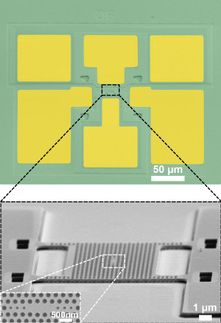Agilent Technologies Awards 2012 Russell Varian Prize for Innovation in Nuclear Magnetic Resonance
Awardees are Ray Freeman and Weston A. Anderson
Agilent Technologies Inc. announced that it has awarded the 2012 Russell Varian Prize for Innovation in Nuclear Magnetic Resonance to two scientists for their seminal paper, “Use of Weak Perturbing Radio-Frequency Fields in Nuclear Magnetic Double Resonance,” published in 1962 in the Journal of Chemical Physics.
The two scientists, Dr. Ray Freeman and Dr. Weston A. Anderson, collaborated on groundbreaking research that has generated important advancements in NMR throughout the past 50 years.
“It is our privilege to pay tribute to these early innovators in NMR technology,” said Regina Schuck, Ph.D., general manager of Agilent’s Research Products Division. “Their invaluable work has provided an easily applicable approach to the unraveling of complex NMR spectra and molecular structure, and has been the catalyst for many notable developments, including a cornerstone of today’s techniques, two-dimensional NMR.”
Freeman and Anderson initiated their collaboration on NMR in the early 1960s, following Freeman’s acceptance of a post-doctoral position at Varian, where Anderson was working as a principal scientist. Now retired, the two men live in the UK and U.S., respectively.
Freeman recalled, “I left the United Kingdom to join Varian primarily because I wanted to work with Wes Anderson—I wanted to be the sorcerer’s apprentice—but also because Varian enjoyed a tremendous reputation for original research. A few days after my arrival, I delivered an informal presentation about my work in England and showed a slide of some double-resonance spectra. The epiphany came following a casual remark from a colleague who noted that that one particular trace ‘seemed to show a tickling effect.’ It was that observation that inspired our future experiments together.”
“For the most part, I did the theoretical analysis and Ray Freeman did the experiments,” added Anderson. “Prior to meeting at Varian, Dr. Freeman and I had both independently conducted double-resonance experiments, so it was natural for us to collaborate on additional studies in this area. Together, we discovered that by irradiating a single line of the spectrum by a weak RF field, all lines with energy levels in common with the irradiated line would be split into doublet. This procedure ultimately aided in the analysis of complex spectra.”
The Russell Varian prize honors the memory of the pioneer behind the first commercial nuclear magnetic resonance spectrometers and cofounder of Varian Associates, which is now part of Agilent Technologies. The prize is awarded to researchers based on a single innovative contribution (a single paper, patent, lecture, or piece of hardware) that has demonstrated a broad impact on the state of the art in NMR and original contributions that have triggered important advancements in scientific technology.
Other news from the department science
Most read news
More news from our other portals
See the theme worlds for related content
Topic World Spectroscopy
Investigation with spectroscopy gives us unique insights into the composition and structure of materials. From UV-Vis spectroscopy to infrared and Raman spectroscopy to fluorescence and atomic absorption spectroscopy, spectroscopy offers us a wide range of analytical techniques to precisely characterize substances. Immerse yourself in the fascinating world of spectroscopy!

Topic World Spectroscopy
Investigation with spectroscopy gives us unique insights into the composition and structure of materials. From UV-Vis spectroscopy to infrared and Raman spectroscopy to fluorescence and atomic absorption spectroscopy, spectroscopy offers us a wide range of analytical techniques to precisely characterize substances. Immerse yourself in the fascinating world of spectroscopy!






























































